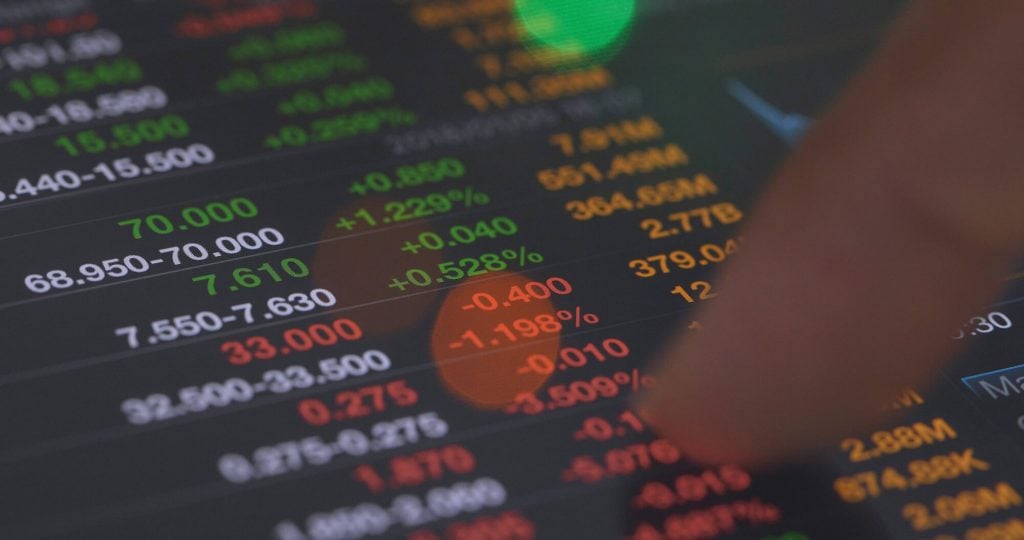
Nearly half of all Americans don’t invest in the stock market. There are plenty of reasons why: Fear, mysteriousness, inexperience, or just lack of interest.
But one of the biggest reasons is concern about how much money investing really costs. According to MarketWatch, many stock market holdouts simply believe they can’t afford to invest.
They believe that you have to spend money to make money — which is true. But they don’t believe the costs associated with stock investing are worth the risk.
How much is it to buy stock? And is it something you can afford to do?

How Much Is It to Buy Stock at the Beginning?
Got a $20 bill in your pocket and don’t feel like taking someone out to lunch? Great — you can start investing in stocks!
That’s the technical answer. There’s no real minimum amount of money you need to start investing in stocks. Most online brokerages don’t require you to maintain a minimum balance in your account, although you obviously need some money to start trading.
How Much Do Share Prices Cost?
Share prices on the stock exchange run the gamut from “dirt cheap” to “down payment on a mansion.” That $20 bill can get you one share in a relatively well-known company or a handful of shares in a startup.
Now, of course, that’s not necessarily the best strategy for starting in the stock market. Cheap stocks are cheap for a reason. The company might not have established itself as a dominating force in the marketplace yet. It might only be beginning to find its footing. Perhaps it has fallen on hard times. And $20 probably isn’t enough to get you started on a meaningful investment journey.
How Much to Start With
So it’s good to start off with a bit more for initial investment. Well, frankly, a lot more. But it should be an amount you can afford without cutting into the other items in your household budget.
Here are some of our thoughts. If you’re a young graduate who’s just started to earn their own money in the workforce, you might want to save up until you have $200 to start an investment account. You’ll want to treat it like a savings account — keep socking away money in that account on a regular basis, whatever you can afford. But $200 will get you at least a few shares in some well-rated stocks or one share in a company that’s fairly successful and dependable.
If you’ve been working for a while and have achieved a certain level of stability, but haven’t yet entered the stock market, consider starting with $1,000. That’s enough to launch a very respectable and diverse portfolio, including a couple of blue-chip companies and a fair mix of potential growth stocks. You’ll also want to make regular contributions to your investment account to keep it growing –this is true no matter what level of investor you might be.
The more you can afford to put in the stock market, the better. But for brand-new investors without million-dollar inheritances to keep them happy, whatever point between $200 and $1,000 you’re comfortable with is likely enough to get started.
How Much Does It Cost to Buy a Stock?
As we’ve mentioned, the range of share prices on the stock market is very broad. The key to becoming a successful investor isn’t so much what you spend, but how you spend.
You can grab one share of Apple right now at about $123. That’s actually a pretty good deal, considering they’re the most valuable U.S. company on the planet. Conversely, you can buy shares of an up-and-coming tech stock for virtual pennies, even less than $10. And both may be equally valid opportunities for future growth.
The share price isn’t really the most important factor when it comes to stock investing. It’s important, that is, but not the only factor you should consider. There are plenty of other things that speak to a given stock’s prospects.

Asset Allocation
What actually matters in terms of your portfolio is how you spread the money around — as they call it, asset allocation.
If you have $500 to spend on stocks, you could consider buying three shares of Apple for a total of $469. It’s certainly not a bad choice. But you only have $31 left over to invest in another company until you put more money in your investment account. For the time being, your fortunes will be tied to the gang in Cupertino and virtually nobody else.
Instead, what if you bought one share of Apple at $123, two shares in Pfizer for $78, two shares in a regional furniture company at $94, a share in a biotech stock at $110, and because you’re thirsty, one share in Anheuser-Busch at $77?
You’d spend a total of $482 on that theoretical stock spree. You’d have three well-known companies in your portfolio, plus a couple of lesser-known companies that hopefully have brighter futures ahead of them. And they’re all in different business sectors: Tech, pharmaceuticals, consumer goods, healthcare, and beer.
That’s an example of asset allocation, a strategy that’s used to diversify one’s portfolio. It’s better to have your investments spread out over several different companies and industries, rather than focusing on just one or two.
That doesn’t mean you should go out and spend $500 on dirt-priced shares in 100 different start-ups, though. It’s wiser to have at least a few holdings in companies that you know and trust will be around for the long haul. But finding the right balance for a diversified portfolio is one of the surest ways to find success in a stock market filled with uncertainty. That’s more important than how much each stock costs.
How Much Does It Cost to Buy a Stock — and Who Decides the Price?
Thousands of micro-details ultimately come into play in setting stock market prices, with most of them falling under the loose category of supply and demand. But to be concise about it, two parties govern the setting of stock prices, and one of them is — well, you, in a way.
How Prices Are Set and Why They Change
When a stock gets listed on the exchange for the first time in an initial public offering, its share price is set by the company, in collaboration with investment partners and financial advisors. They set a price they believe is affordable for the general investing community, impressive enough to encourage bigger investors, yet reasonable to show substantial profits in the future.
After that point, the share price is determined by trading volume. If there’s a run on the stock and a lot of investors are buying it, the share price goes up. If investors start shedding their shares and can’t get rid of them fast enough, the price goes down.
So in that sense, you and other investors are setting the share prices based on your transactions. Other market forces play a part in driving those transactions — earnings reports, institutional investor levels, breaking news, TV analysts — but at heart, the main driver of stock prices in either direction is trading volume.
A company may also decide to split its stocks, which results in share prices going either up or down dramatically. In that case, portfolios would either gain or lose a physical number of shares in the company, but they wouldn’t actually lose overall value. But that’s for another post.
How Much Does a Stock Cost in Additional Expenses?
Anyone with a bank account, a utility bill, cable TV, a lawyer, or a credit card knows that you don’t just spend money on goods and services. Sometimes, you have to pay service, transaction, or penalty fees, as well.
That has certainly been the case with stock brokerages, too — but not nearly as much today as in the past.
Back in the old days, private investors like you had to work with an outside entity to buy stock — typically a human stockbroker. And that meant paying for all the various forms of activity on your account. Your stockbroker might have also worked on commission.
When the internet made retail investing more accessible to all, online brokerages sprang up and the human stockbroker went the way of the fax machine– useful to only a small, kind of curious segment of the population.
Yet online brokerages continued to charge transaction fees until a very short time ago — the middle of 2019, in fact. When mobile investment apps that charged zero in transaction fees became popular, the traditional brokerages (Fidelity, Schwab, Merrill) with online presences realized they had to follow suit.
So, these days, online brokerages generally don’t charge anything for normal investment activity. They may charge fees for advanced or premium services they may offer. But usual, uncomplicated, buy-and-sell transactions are almost all free of charge.

Gorilla Trades: Maximizing Your Stock Profit Potential
Gorilla Trades can help to reduce your anxiety about playing the stock market. Our stock picks help clients find the right investments at the right times to realize significant gains. We’ll take the mystery out of Wall Street and show you how to turn it into a dependable source of real profits. Start a free trial to learn more.
